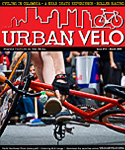Effectively Promoting Bicycling, Walking and Transit Use
By Dom Nozzi
John Pucher has made the point that some of the tactics being used in Germany may seem politically unlikely in car-happy nations such as the US, but these more aggressive, effective policies for growing new bicyclists, pedestrians and transit users become more feasible as transportation problems such as congestion and energy costs become so intolerable “that the majority of voters, and the politicians they elect, are finally willing to do something about them.”
I am in full agreement with John Pucher, as I note in my book, The Road to Ruin, and in my urban design and presentations. Indeed, I am increasingly convinced that we need to find a way to leverage increased congestion, increased use of priced & scarce car parking, gas tax increases, increased urban densities, increased road dieting, increased traffic calming, and more road pricing if we, in the US, expect to effectively grow the number of bicycle, pedestrian and transit commuters.
In other words, by using price and convenience signals.
Admittedly, these tactics are exceptionally difficult, politically. As a result, we end up only using ineffective tactics (and then getting more cynical when such tactics fail).
But I remain optimistic that as our transportation and financial problems worsen due to dwindling oil supplies and our on-going auto dependency, that political leadership will emerge (it has been in very scarce supply for several decades, largely due to the lack of sufficiently worrisome crises).
I am also growing more fond of the idea that by using effective tactics and thereby meaningfully increasing the number of bicyclists, pedestrians and transit users, we will begin to see a virtuous cycle forming. A self-perpetuating loop that provides desirable changes on its own.

A substantial rise in the cost of gasoline provides an example of a virtuous cycle. As gas costs rise, most motorists seek to make changes that will reduce the rising cost of driving a car. Some may drive less, and walk or bicycle or use transit more. Others will drive more fuel-efficient (and smaller) cars. Or start living closer to their destinations. Not only does this improve household and government finances (due to avoided transportation costs such as car and gasoline purchases, and lower road construction and maintenance costs). It also improves public and environmental health (due to more physical exercise and lower pollution emissions). These changes incrementally induce non-auto transportation improvements. The changes also result in more compact, mixed-use land use patterns. Which induces even more walking, bicycling and transit use.
And so on.
Another example is that many in the US don’t bicycle, walk or use transit even though they have reasonably short travel distances. I believe that at least some of that reluctance is due to a perception that non-car travel is unsafe. Or not “hip.” If motorists start seeing growing numbers of their fellow citizens getting around by bicycling, walking or using transit, such travel will seem more “normal” and therefore more desirable for the larger population.
And that can help recruit more non-car travel. Which further promotes the “safe and hip” perception. Which then recruits even more to ride a bicycle, walk, or take the bus.
And so on.
In addition, a larger number of non-car travelers can, I’m convinced, result in dramatic safety improvements (via “safety in numbers,” and all that implies).
Visit my urban design website read more about what I have to say on those topics. You can also schedule me to give a speech in your community about transportation and congestion, land use development and sprawl, and improving quality of life.
Visit: www.walkablestreets.com Or email me at: dom@walkablestreets.com











0 comments:
Post a Comment